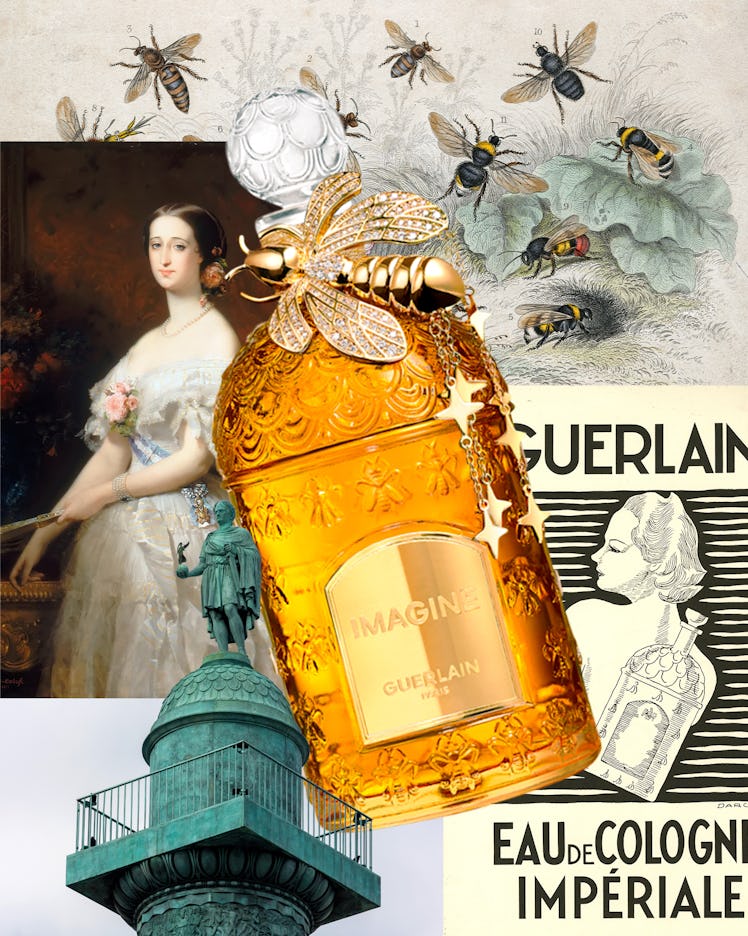The Surprisingly Rich History of Guerlain’s Bee Bottle
A 19th-century fragrance is still generating a lot of buzz.

What to give the woman who has everything? It’s a question that consumed Pierre-François-Pascal Guerlain when he was tasked with creating a fragrance to commemorate Empress Eugénie’s marriage to Napoleon III, in 1853. While the perfumer got to work on blending notes of bergamot, lemon, neroli, and petitgrain, he turned to the master glassmaker Pochet du Courval to design a bottle that was as stylish and memorable as its spirited young recipient.
Guerlain’s fragrance, Eau de Cologne Impériale, was presented in a distinctive flacon engraved with the emperor’s coat of arms and adorned with bees—a long-standing emblem of the French empire—hand-gilded with fine gold. Its cylindrical design was inspired by the Napoleon I column in the Place Vendôme in Paris, located just a spritz away from Guerlain’s first boutique. The perfume earned the company the title “Official Supplier to Her Majesty the Empress” and the admiration of the ladies at court. After Empress Eugénie, Guerlain’s royal customers included Queen Victoria of Great Britain and Queen Isabella II of Spain.
Eugénie de Montijo, Empress of the French, an 1854 portrait by Édouard Louis Dubufe of the monarch for whom Guerlain’s Eau de Cologne Impériale was created.
Guerlain’s Imagine, a new fragrance honoring the 170th anniversary of Cologne Impériale’s original Bee Bottle, in an updated flacon by Atelier Truscelli.
The Bee Bottle continues to set fashionable circles abuzz. “A new clientele is looking for luxury with roots anchored in history and culture, which can hopefully be passed on from one generation to the next,” says Ann-Caroline Prazan, Guerlain’s director of art, culture, and heritage. The company’s exacting artisans, known as les dames de table, still painstakingly seal the perfume stoppers by hand with fine thread, using the time-honored technique of baudruchage, which predates modern vacuum seals. In addition to the original Eau de Cologne Impériale, today’s nouvelle empresses can fill four different Bee Bottle sizes with the Guerlain fragrance of their choice and add a personalized inscription. “It’s a customizable symbol of the exceptional, made with ancient traditional know-how,” adds Prazan.
An 1850s study of bees—a symbol of the French empire and the dominant motif on the Cologne Impériale bottle—by the artist J. Stewart, engraved by J. Bishop.
The Bee Bottle is also becoming a source of inspiration for contemporary artists and creators. For a 2021 collaboration with Guerlain, emerging Swiss designer Kevin Germanier fashioned 11 vessels using upcycled Swarovski crystals to recall sumptuous couture garments; jewelry designer Begüm Khan made 15 pieces with Turkish craftspeople in a historic workshop in the Old City quarter of Istanbul, setting precious stones in gold-plated bronze; and, this past May, in honor of World Bee Day, the Slovakian artist Tomáš Libertíny, who creates living sculptures by inviting actual bees to build their honeycombs around prefabricated frames, constructed a hive around the bottle’s beveled edges over the course of a month to produce a decorative wax trim. Libertíny created a tribute fit for a monarch—no surprise, given that his most famous artwork is a wax bust of Nefertiti made in collaboration with 60,000 little pollinators.
A 1936 advertisement for the cologne.
The Vendôme Column in Paris, crowned with a statue of Napoleon I as Caesar, inspired the bottle’s cylindrical shape.
To celebrate the Bee Bottle’s 170th anniversary in the new year, Guerlain just released a limited-edition fragrance, Imagine, housed in yet another array of ultra-exclusive bottles, created in partnership with the Parisian jewelry studio Atelier Truscelli. Collecting them all might feel a little de trop for some, but as Nefertiti herself might have said, without that touch of honey, what would a queen be?
One of Guerlain’s dames de table, at work in the company’s Courbevoie factory, 1950s.
This article was originally published on